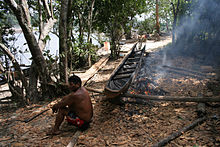Yeꞌkuana
 | |
| Regions with significant populations | |
|---|---|
| Brazil | 430[1] |
| Venezuela | 6,250[2] |
| Languages | |
| Yeꞌkuana language | |
| Religion | |
| Animism | |
The Yeꞌkuana, also called Yeꞌkwana, YeꞌKuana, Yekuana, Yequana, Yecuana, Dekuana, Maquiritare, Makiritare, Soꞌto and Maiongong, are a Cariban-speaking tropical rain-forest tribe who live in the Caura River and Orinoco River regions of Venezuela in Bolivar State and Amazonas State. In Brazil, they inhabit the northeast of Roraima State. In Venezuela, the Yeꞌkuana live alongside their former enemies, the Sanumá (Yanomami subgroup).
When the Yeꞌkuana wish to refer to themselves, they use the word Soꞌto, which can be translated as "people", "person". Yeꞌkuana, in turn, can be translated as "canoe people", "people of the canoes"[3] or even "people of the branch in the river".
They live in communal houses called atta or ëttë. The circular structure has a cone-shaped roof made of palm leaves. Building the atta is considered a spiritual activity in which the group reproduces the great cosmic home of the Creator.
The first reference to the Yeꞌkuana was in 1744 by a Jesuit priest called Manuel Román in his travels to investigate the existence of the Casiquiare canal.[4] He recruited the services of the Yeꞌkuana to help him on his way.
The Alto Orinoco-Casiquiare Biosphere Reserve was established by the Venezuelan government in 1993 with the objective of preserving the traditional territory and lifestyle of the Yanomami and Yeꞌkuana peoples.[5] There are some 6,250 Yeꞌkuana in Venezuela, according to the 2001 census, with some 430 in Brazil.
Jean Liedloff came into contact with the Yeꞌkuana in the 1950s, while working as a photographer for Italian diamond-hunters, and in subsequent personal visits. She based her book The Continuum Concept: In Search of Happiness Lost on their way of life, particularly the upbringing of their children. Liedloff noted the stark contrast between the treatment of Western and Yeꞌkuana infants, who are normally held "in-arms" 24 hours a day by their mothers and by other familiar adults and children who take care of them.[6]
Notes
[edit]- ^ Encyclopedia of Indigenous Peoples in Brazil
- ^ 2001 Census of Venezuelan Indigenous Groups
- ^ Yeꞌkuana – Our World
- ^ Guss, David. M. (1990) To Weave and Sing: Art, Symbol, and Narrative in the South American Rainforest, page 5
- ^ "Alto Orinoco-Casiquiare", MAB Biosphere Reserves Directory, UNESCO, retrieved 2017-04-02
- ^ Liedloff, Jean. "The Importance of the In-Arms Phase". Retrieved 5 February 2013.
Further reading
[edit]- David. M. Guss: "To Weave and Sing: Art, Symbol, and Narrative in the South American Rainforest" (University of California Press, 1990)
- Jean Liedoff: "The Continuum Concept: In Search of Happiness Lost" ISBN 0-201-05071-4
- Knab-Vispo, C. C. (2003). Ecological observations on heteropsis spp. (araceae) in southern Venezuela. Economic Botany, 57(3), 345–353.
